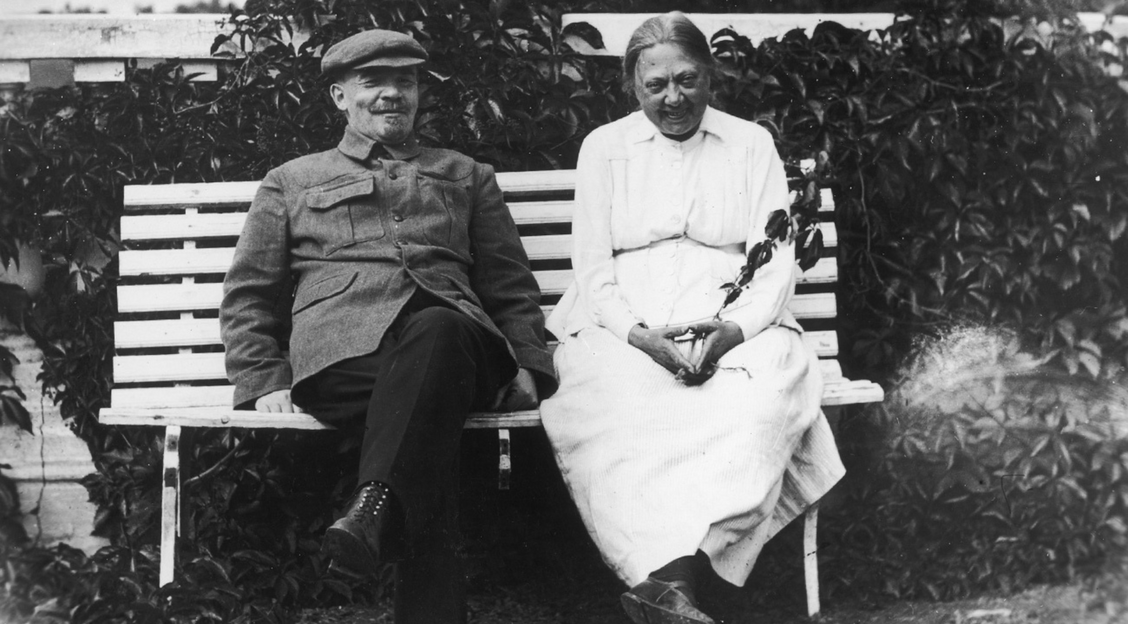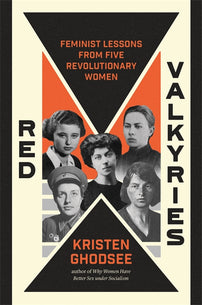Love and Revolution: The Inessa-Lenin-Krupskaya triangle
“If you fall in love with a struggle, it is easy to fall in love with those who share that struggle and vice versa.”

Nadezhda Krupskaya was the first Russian socialist to dedicate a whole pamphlet to the situation of women. Written in 1899 under the pen name Sablina, “The Woman Worker” drew a disturbing portrait of the fate of women under Russian capitalism and in the traditional peasant family. Krupskaya specifically called upon Russian women to take up the struggle against autocracy, and painted an evocative picture of the better world that was possible if they joined the working-class movement.
In many ways, Krupskaya’s life embodied her philosophy about collaborating with men for the greater cause, and while Lenin certainly gave her important responsibilities, he also relied on her to organize the couple’s domestic affairs. Although Krupskaya kept her maiden name, she took pride in dealing with all of the quotidian necessities of human existence and in caring for her temperamental and demanding husband.
It was in 1894, while working in Saint Petersburg, that Krupskaya first met a certain young Marxist intellectual named Vladimir Ilyich Ulyanov, who later took the name Lenin. Having dropped out of the boring Bestuzhev courses, she attended several informal circles where different groups gathered to discuss literary and political works. Little is known about their initial romance because Lenin and Krupskaya remained silent on the issue throughout their lives.
The events leading up to Krupskaya’s marriage to Lenin suggest that it served at least partially as a convenient cover for their political activities. During the years they attended or taught in various political circles, the police surveilled them. Lenin was arrested in December of 1895, but so minimal was the connection between him and Krupskaya that the police ignored her until May of 1896, when they began surveilling her, and arrested her in August 1896. In the eight months between Lenin’s imprisonment and Krupskaya’s, they sent each other messages using “invisible” milk ink, a common communication strategy to avoid the prying eyes of the secret police in which a secret letter would be written in milk between the lines of an innocuous letter written in ink. The milk would dry and become “invisible.” Because the chemicals in the milk weakened the paper, the milk ink would “develop” when the letter came into contact with heat and reveal the hidden message. Although political prisoners had no access to flames, they were often served tea hot enough to develop the invisible ink by holding the letter on or over the cup.
In addition to their hot tea and milk, political prisoners could receive unlimited visits from family members and from their spouses or fiancées. It is important to remember that many of these intellectual revolutionaries (including Lenin, Krupskaya, and Inessa Armand) hailed from the noble or bourgeois classes. The tsar perhaps saw them as angst-ridden youth rebelling against their high-status parents and dealt mildly with them, perhaps in hopes that they would grow out of their revolutionary zeal and eventually join their parents in the ranks of Russia’s elite.
Political prisoners were allowed visits from those to whom they were engaged and radicals in the Russian underground abused this fiancée provision to their own advantage, assigning fake fiancées to imprisoned men for the duration of their confinement. Krupskaya and other politically committed women volunteered for these roles and became couriers of messages, books, writing materials, and other necessities between prisoners and their conspirators. Between December 1895 and August 1896, Krupskaya became Vladimir Ilyich’s political “fiancée.”
She and Lenin never had children (possibly due to her thyroid condition) and witnesses claimed that she slept in her mother’s room rather than in her husband’s while they lived in exile. After the revolution, they often lived apart, and Krupskaya became Lenin’s regular companion again only when he needed an attentive nurse: first after he was shot at close range by Fanny Kaplan on August 30, 1918, and later after he suffered from a series of increasingly debilitating strokes.
Krupskaya’s most affectionate relationship was with Inessa Armand. The most tender and evocative language in her memoir appears not in passages about Lenin or her mother, but when she describes time shared with Armand, whom she first met in France. The 1910 Paris crowd included Alexandra Kollontai and Alexander Shlyapnikov; Armand began attending the talks and events organized by the Russian émigré community. “Inessa Armand arrived in Paris from Brussels in 1910 and immediately became an active member of our Paris group,” Krupskaya wrote. “She was elected to the presidium of the group and started an extensive correspondence with the other groups abroad. She had a family of two little girls and a boy. She was a hot Bolshevik, and before long our whole Paris crowd had gathered around her.”
During this time, Krupskaya, Lenin, and Armand decided to organize a summer school in the village of Longjumeau, near Paris. Armand rented a house, which served as a canteen for students who rented rooms in the village. Krupskaya recalls fondly that she and Lenin rented rooms in a brick house at the other end of the village, but always dined in the common room at Armand’s place, where they enjoyed long conversations with the students. When Lenin and Krupskaya moved back to Paris in 1910, after the summer, Armand rented the apartment right next to theirs and saw them almost every day.
After leaving Paris, Lenin and Krupskaya settled in Cracow/Kraków (in Austrian Poland) with Krupskaya’s mother, who was ill. Armand eventually joined them after serving a harsh prison sentence in Russia. Much to Krupskaya’s surprise, Armand arrived ready to labor: “She had lost none of her old energy, however, and threw herself into party work with all her usual zest.” Krupskaya waxed lyrical about their months together:
That autumn all of us—our entire Cracow group—were drawn very close to Inessa. She was just brimming with vitality and exuberant good spirits. We had known her in Paris, but the colony there had been a large one, whereas in Cracow we lived together in a small close and friendly circle. Inessa rented a room in the same house where Kamenev lived. My mother was greatly attached to her. Inessa often came to have a chat with her, or sit and smoke. Things seemed cosier and more cheerful when Inessa was there. Our home life was more like that of students, and we were very glad to have Inessa. During this visit of hers, she told me a great deal about her life and her children, and showed me their letters. There was a delightful warmth about her stories. Ilyich and I went for long walks with Inessa.
After the beginning of World War I and Lenin’s arrest in Poland, Krupskaya and Lenin fled to Switzerland. Armand decided to join them for several months. From Krupskaya’s descriptions of their time in Berne, it seems the trio spent many happy hours in each other’s company:
Krupskaya briefly mentioned moments when she and Armand shared time alone together without Lenin—when they searched for rooms in Cracow or visited a comrade in the hospital. Their personal letters make clear that the two women shared a strong personal as well as political bond and raise some interesting possibilities. Robert McNeal, one of Krupskaya’s biographers, also found the relationship between the two women atypical:
The Inessa-Lenin-Krupskaya triangle poses a number of riddles that can neither be fully solved nor simply ignored in a life of Krupskaya. For one thing, it was a triangle, not just a “V” formed by one person’s relationship with two others, as in so many alleged triangles. In time, at least, there was a close personal bond between Inessa and Krupskaya, as well as between Inessa and Lenin. Krupskaya personally edited a special volume of tributes after Armand’s death in 1920, and she essentially adopted two of Armand’s younger children, caring for them as if they were her own.
If Krupskaya’s initial betrothal and ultimate marriage to Lenin occurred for the sake of politics, it is not unreasonable to ask whether the two ever shared a romantic life together, especially after their initial “honeymoon” in Siberian exile. Could it have been a ménage à trois? This seems doubtful, given that Krupskaya seemed rather constrained in her sexual mores. Perhaps Krupskaya had committed to leading a dedicated, ascetic life like her youthful role model Tolstoy. Or maybe she harbored a secret love for Inessa, or openly cultivated a “passionate friendship,” a not uncommon arrangement among Victorian women of her time.
As both Vivian Gornick and Maple Razsa have described in their work on communist and anarchist movements, romance has played a large role in drawing individuals into revolutionary causes. “Powerful feelings of camaraderie, commonality, loyalty, solidarity—even love for one another and the collective—are a critical part of radical political experience, born of shared struggle,” writes Razsa. “In some cases, these experiences are at the very emotional center of individual motivation and inspiration.” If you fall in love with a struggle, it is easy to fall in love with those who share that struggle and vice versa.
— An edited excerpt from Red Valkyries: Feminist Lessons From Five Revolutionary Women by Kristen Ghodsee.
Enjoy 40% off select titles on love, sex, desire, and more for one week only! Add any three books from the list to your cart and the 40% discount will extend to any Verso title site-wide and will be applied at checkout, up to three per order.
[book-strip index="1" style="buy"]
